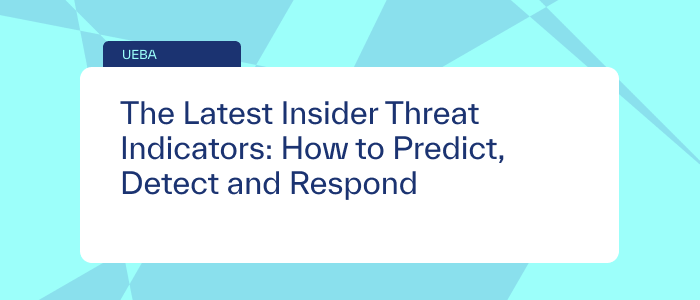
It’s common for organizations to spend most of their cybersecurity budget and efforts on preventing, detecting, and combatting threats that originate from outside the organization. However, while external threats might get more attention, the potential damage from insider threats should not be underestimated. Malicious or negligent actions from employees, contractors, or business partners can lead to significant breaches, data loss, and damage. An effective cybersecurity strategy should address both external and insider threats to ensure comprehensive protection of sensitive data and digital assets.
A different kind of mentality and different toolsets are required for detecting insider threats from the approaches used for external threats. This article discusses the latest insider threat indicators and looks at the tools and techniques for, not just detecting but actually predicting, when a threat poses real risk. This can be done by analyzing patterns and behaviors that serve as insider threat indicators.
Detecting insider threats can be challenging because insiders often have legitimate access to systems and data. However, certain behaviors and patterns can serve as indicators of potential insider threats.
The list of insider threat indicators is extensive, but some additional ones include: excessive use of privileges, unauthorized use of credentials, data exfiltration, logins from multiple locations, unapproved software installations, violations of policies, and excessive data printing.
Given that an insider usually has access privileges that are a normal part of their work processes, the key to predicting an insider threat is to monitor all users for risky and anomalous behaviors, determine their severity, and assess whether they could cause damage or whether malicious activity is about to occur or is currently taking place.
User and Entity Behavior Analytics (UEBA) is often advocated as the best means to detect nefarious or potentially damaging activity by internal actors. UEBA involves keeping track of what users are doing and looking for behaviors that are outside the range of normal activities. This, then, is combined with in-depth intelligence about a user’s identity attributes and the privileges they have on the network. This approach involves analyzing the access rights and entitlements a person has; the activities they have been performing across multiple accounts, both now and in the past; and the typical activities that members of their peer groups are performing. It takes a combination of the right data sources, sophisticated machine learning, and perceptive data science to pinpoint truly aberrant actions that can be seen as insider threat indicators.
Insider threat solutions can help. Given that an insider usually has access privileges that are a normal part of their work processes, the key to predicting an insider threat is to monitor all users for risky and anomalous behaviors, determine their severity, and assess whether they could cause damage or whether malicious activity is about to occur or is currently taking place. This process can be significantly enhanced by implementing robust insider threat tools.
Malicious or negligent workers, or those posing as one through the use of compromised credentials, can represent a significant cyber risk to any organization. Preventing and detecting such threats requires a different approach than the typical external cyberattacks.
The most effective way to pinpoint the presence of insider threats, without creating a lot of false positive alerts, is to overlay user activities with user identity intelligence, cluster identities into dynamic peer groups, create time-based behavioral baselines, and continuously learn what is acceptable behavior in order to spot the unacceptable behavior. It takes a combination of the right data sources, sophisticated machine learning, and predictive analytics to pinpoint truly divergent actions that are good indicators of misuse of assigned privileges.
Insider Threat Demo
The main distinction between insider threats and external threats lies in the source of the threat and the level of authorized access to the organization’s resources. Insider threats involve individuals who have internal access and often use their legitimate privileges to commit malicious actions. External threats come from unauthorized individuals outside the organization who seek to breach the organization’s defenses and gain access to sensitive information or disrupt operations. Both types of threats require tailored cybersecurity strategies to mitigate their risks effectively.
Not all insider threats are intentional. A person can accidentally or negligently violate a security policy that inadvertently results in a breach. For example, an employee could install software on their workstation that opens a backdoor into the organization’s network.
The best way to monitor for insider threats is to look at users’ behaviors, watching for anything that seems to be unusual and risky. Some common behavioral indicators include logging in at unusual times or from unusual locations; moving, copying, or deleting large amounts of data; attempting to access systems or applications for which they have no legitimate business purpose; conducting activities that are not commonly performed by the worker’s peer group.
Predictive analytics adds an extra layer of sophistication to insider threat detection by leveraging advanced data analysis techniques to identify suspicious behaviors and patterns. This proactive approach is essential for mitigating the risks associated with insider threats and protecting an organization’s sensitive information and assets.
The latest insider threat indicators reveal a concerning trend in the cybersecurity landscape. According to Gurucul’s 2023 Insider Threat Report, security professionals are increasingly worried about the rising frequency and sophistication of insider attacks. The report found that 74% of organizations feel moderately to extremely vulnerable to insider attacks, with more than half of respondents reporting an insider attack in 2022.
Monetary gain was identified as the primary motivation for insider threats at 59%, closely followed by reputation damage, theft of intellectual property, and fraud. Compromised accounts and machines are the top concerns for 71% of security professionals. As insider threats become more challenging to detect and prevent, organizations are urged to dedicate significant resources to defend against them in 2024. These findings emphasize the critical need for proactive measures and advanced behavioral analytics, such as Gurucul User Entity Behavior Analytics (UEBA), to promptly detect and manage insider risk. The full report can be accessed for further insights and recommendations.
